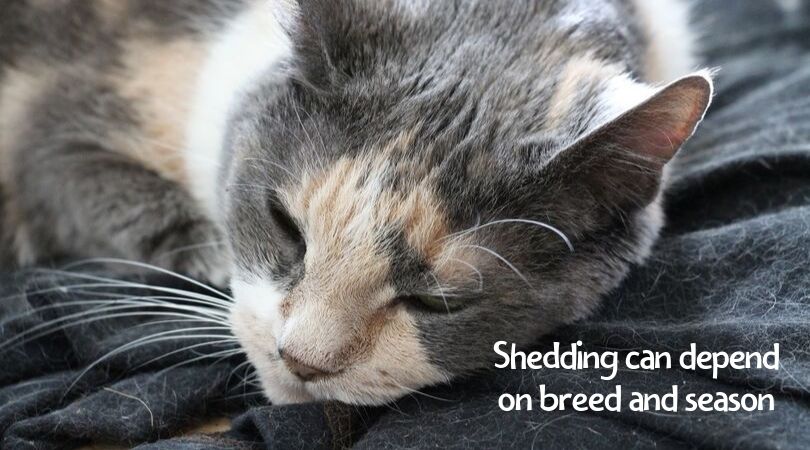Shedding is just one of those things that come with having a cat or dog, but how much shedding is normal, and when does excessive hair loss signify a medical issue?
What is a “Normal” Amount of Shedding?
While it’s expected for your dog or cat to leave his or her hairs here and there (think of it as their “calling card”), what is considered a normal amount of shedding? The answer is: it depends. Long-haired breeds of dogs and cats may shed more than short-haired breeds. Additionally, your pet may shed more in the warmer seasons than during colder weather.
The Merck Veterinary Manual reminds pet owners to keep in mind that the natural growth cycle of new hair is always accompanied by the shedding of old hair. Your pet’s shedding may seem excessive, but if it “is not accompanied by bald patches or symmetric hair loss, it is likely the shedding is just a stage in the natural replacement of the hair coat.”

Causes of Problematic Pet Hair Loss
Abnormal pet hair loss can be due to a wide range of concerns – from easy to resolve, such as fleas, to more serious issues, such as kidney disease. Some of the many causes of problematic pet hair loss include:
- Allergies – to food, medications, environmental allergens, or fleas
- Parasites – fleas, lice, or mites
- Mange (canine scabies) – also due to mites
- Fungal or bacterial infections – can be simple or complex
- Kidney, liver, thyroid, or adrenal disease (including Cushing’s)
- Cat cancer/Dog cancer
- Pregnancy or lactation
- Skin conditions such as eczema, dandruff, or sunburn
- Nervous disorders – self-induced trauma due to licking
- Genetics – some breeds of dog are more genetically prone to baldness, including Chihuahuas, Doberman Pinschers, Italian Greyhounds, Whippets, and Dachshunds
When Pet Hair Loss is a Health Issue
If you feel that your dog or cat is shedding more than a normal amount, your first action should be to schedule a visit to your veterinarian. They can help determine if your pet’s hair loss is part of the normal shedding process or is a symptom of an underlying problem, such as stress, poor nutrition, or another medical problem. Your veterinarian will note the pattern and distribution of hair loss on your pet, as well as investigate if hairs are being shed from the hair follicle or broken off. They will also look for signs of secondary skin infections or parasites and may perform skin scrapings to send to the lab for testing. Your vet can then make recommendations on if your pet needs medical treatment or maybe just a better de-shedding brush.
Tips for Dealing with Shedding
If your dog or cat doesn’t have medically problematic hair loss – but it’s still problematic for you – there are some things you can do to cope with the amount of pet hair everywhere in your home (and in your car, and on your clothes, etc.). Here are some tips to reduce the amount of hair in your home:
- Consistently comb your furry friend. Your veterinarian or groomer should be able to recommend the best type of pet comb or brush for your dog or cat’s type of hair.
- Take regular trips to the groomer. If it’s difficult for you to regularly bathe your pet, taking him or her for professional dog or cat grooming on a regular basis is a must! When the groomer shampoos them, a lot of loose hairs will naturally fall out (in the groomer’s sink rather than on your sofa), and subsequent brushing/combing will also capture a large amount of unattached strands.
- Routinely sweep/vacuum your home. Don’t let hairballs start building up around your home. Create a schedule for cleaning up hair from floors and furniture (daily/weekly/monthly?), and your pet’s hair loss won’t seem so excessive.

- Invest in a good lint roller. As any self-respecting fashionista with a pet can tell you: a lint roller is your best friend! They’re inexpensive and they’ll help you keep pet hair-free. Keep one in your purse, in the car, at work, etc. and any time you notice spare hairs on your attire, you can quickly remove them with a few quick swipes.
You will never be able to stop a healthy pet from a normal amount of shedding, but these hair reduction tactics should be preferable to your pet having a medical reason for losing their hair. Just be sure to stay on the lookout for signs of abnormal hair loss, and of course, continue taking your dog/cat for regular wellness exams. And as always, don’t hesitate to contact us with any questions!
